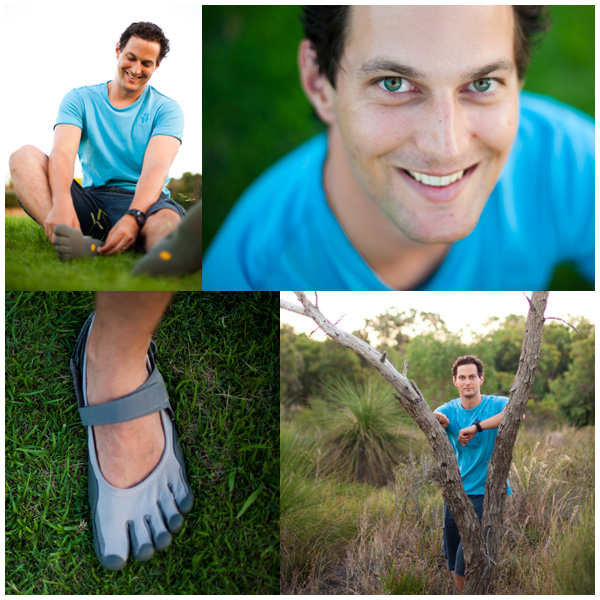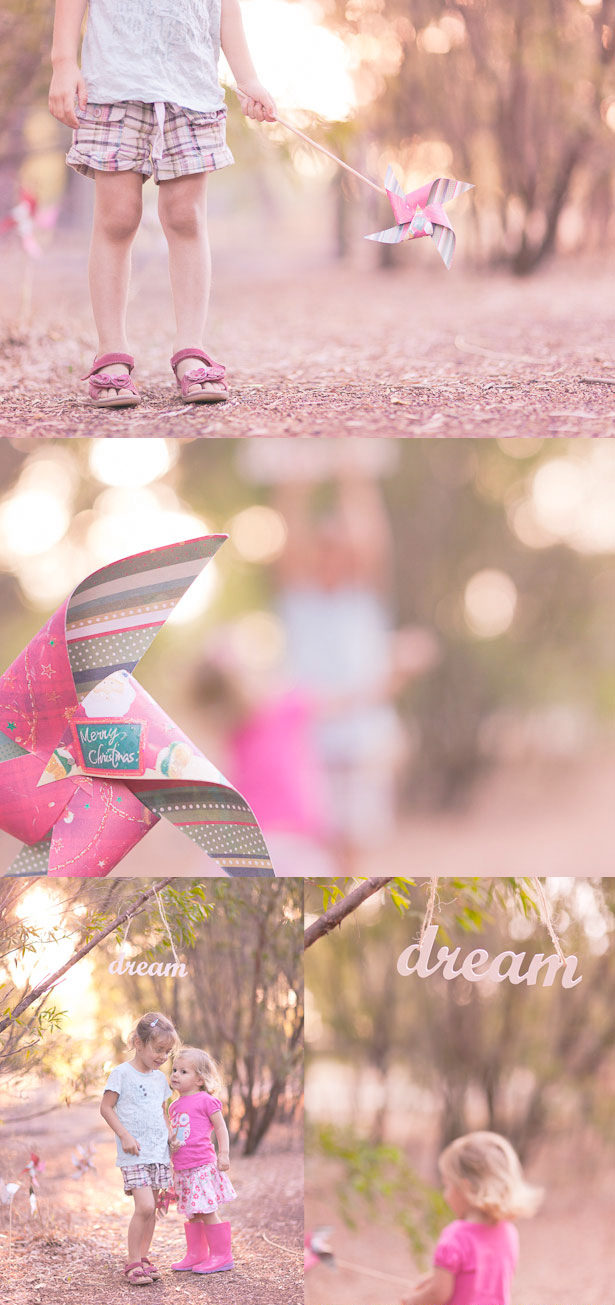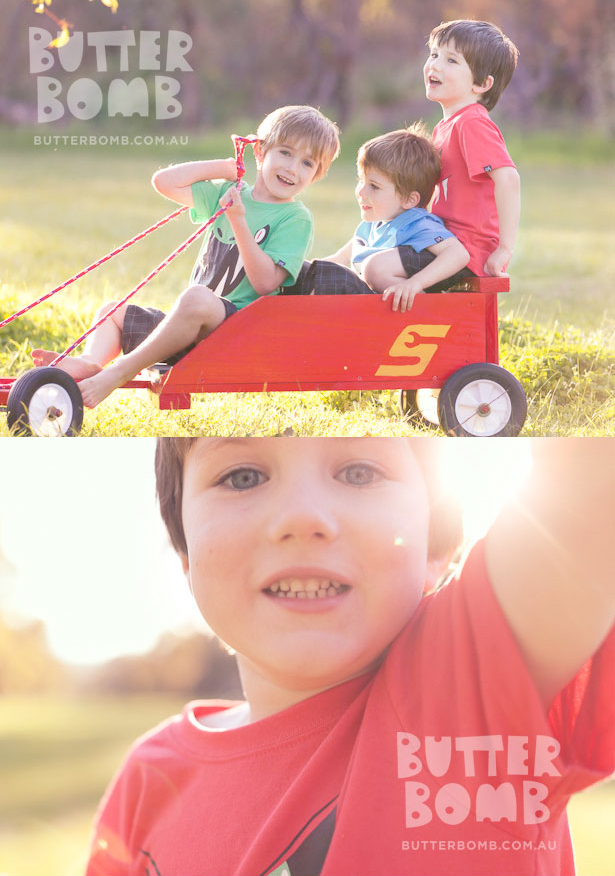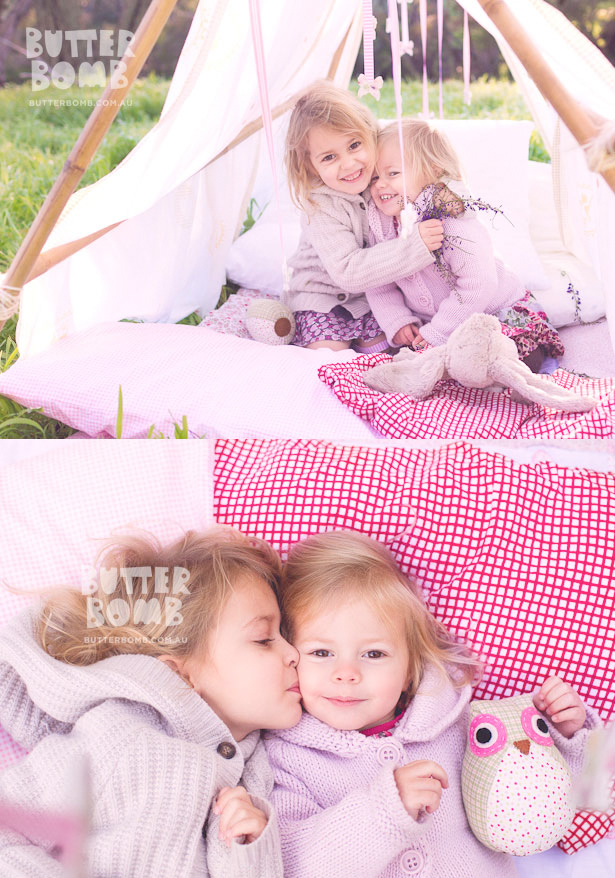Tristan Cameron: Elephant's Undies!

W I T H T R I S T A N C A M E R O N

“A big kid who loves being a photographer” – is a pretty accurate description of family and lifestyle photographer, Tristan Cameron of Butterbomb.
“Elephant’s Undies!” is the catch cry of Butterbomb, the family/lifestyle photography business that Tristan owns with wife, Monika. I must admit that until I met Tristan, I had no idea that these ponderous pachyderms even wore underpants. “What kind are they? What colour are they?” I wanted to ask, but decided that this line of questioning might make me come across as just a little too weirdly curious. So I took the route of the more formal interview which, as it turned out, actually reveals what these jumbo jocks are all about.
Butterbomb – has as its slogan: “We are big KIDS with CAMERAS”, and it’s easy to believe this when you see the amazing energy, fun and warmth in Tristan’s images of kids and families being their natural selves.
It’s the same energy and sense of fun that bubbles to the fore when you speak with Tristan, and it’s very clear that this guy is doing what he loves! In this Venture Masterclass, Tristan shares his passion with us: telling us how he shoots natural light portraiture and giving great tips and techniques for photographing children’s portraiture. Read on!

Can you tell us why these are some of your favourite images.
When I shoot, I want to create a story, describe a personality — the personality of these kids — so that when you view them, you can tell that it’s them at that stage of their life.
I was very happy with the way the personality of the girls have been captured. They were very sweet, and the lighting and setting suited them well.
The girls are sisters, about four and two years old, and the tea party was something they do in their playtime. That tea set has long been destroyed – it was porcelain and toddlers and porcelain don’t go well together. I try to identify things that kids are really into: it could be a tea party or making mud pies, or climbing trees, and to use these in the shoots I do.

The boy was a cheeky little guy who wanted to run around, jump on boats, climb trees, do his superhero poses – basically, he “flew” over the boats.
It’s important for parents to remember what the kids are like at that age – the photos are like bookmarks that trigger memories of what they were like at that time. That’s what I want to achieve in a shoot and these pictures are the ones I’m happiest with.
The thing that strikes me most about both these sets of images is the way you have used light to create a very ethereal effect in these scenes. Can you tell us a bit about the lighting in terms of time of day and how you set up each scene to use this light?
These photos were taken in the last couple of hours before sunset. Between 5.15pm and 7.15pm in Summer.
I typically shoot in back lit situations [light coming from behind the subjects]. I do this because I don’t want shadows on their faces, and back-lighting creates a nice soft even lighting; that is the style I want to go for. Children are innocent and the soft even lighting shows this. You’ll also have the sun coming through hair, rim-lighting the kids, light coming through trees and, if you shoot with a wide aperture, you’ll get beautiful bokeh of dappled light in the background.
The main reason for using back lighting is to create the magical, dream-like light. You get the softness in expression when they are not facing the sun; otherwise, you’ll get photos of squinting kids. When the light is soft, you can get side lighting with soft shadows [gradual transition from light to shadows on the subject] – so with beach shoots, what’s what we’ll do, but we shoot in the last 20 minutes before sunset in summer. In Autumn or Winter, you get a longer window, but in Summer the sun is still harsh until the last 20 minutes of the day. Shooting later in the day gives you that golden light that adds to the magical quality I try to achieve. Kids believe in magic.

What about the locations in which you shoot? How do you decide on a good location for a family shoot?
First, I pick a location where the lighting is going to be good. For me, a suitable location is one where you have sunlight coming through reasonably thick trees in the background. I scout the locations beforehand, especially for locations I’m not familiar with – whether it will be suitable for the time of day we’re shooting. I do keep an eye on sunset times throughout the year, so I can tell when the sun is going to set.
I usually give parents first option on deciding on a location – I prefer them to choose a location. I encourage as much creative input into the shoot from the family – so they feel more ownership and get more benefit from the shoot. Sometimes they have a location that has special meaning for them, like a local area. If they don’t have a location, then I ask them if they have a particular location in mind for example, a park, the bush, the beach, and then I suggest potential locations to them.
I don’t overuse a location – as I want variety in my images, and it impacts on the enjoyment of your work. If you’re shooting for your enjoyment you wouldn’t shoot the same thing every day, so I like to keep it varied.
Shooting in back lit settings can be challenging, because the brighter back light can confuse your camera’s light meter. How to you meter when you’re shooting in this kind of light? Do you use reflectors to bounce some light back?
I expose to the right, which means I basically shoot to fill up the right hand side of the Histogram without clipping the highlights if possible. I prefer to have skin properly exposed rather than have it underexposed and then pushing it in post-production. If you’re able to capture ten stops of dynamic range, the brightest stop represents half the values your camera’s sensor can record. I use spot meter off skin probably 2/3 stops overexposed, then it’s just a check to see what the Histogram is doing. I shoot RAW so you can do recovery on highlights.
I always shoot Manual exposure – because I shoot in unchanging lighting conditions and shooting manual gives me more consistency in post-production. I still use the meter in the camera to help. If I shoot in Aperture Priority, shutter speed can drop too slow and when you’re caught up in shooting, you don’t realise that the shutter has dropped below your focal length guide [ie. your shutter speed has dropped below 1/focal length you’re using] and end up with camera shake blur. So, I shoot Manual exposure because I know what Shutter Speed I want, what Aperture I need, and then I set the ISO to adjust the exposure.
I tend to find natural reflectors, like a concrete wall or a pavement or path, that can reflect light to fill in the shadows. It will provide enough to even out the light across the scene. They also create great catch lights in the eyes – important because they say eyes are windows to the soul, because if you see catch lights in the eyes they become alive and sparkle.

Let’s talk about your equipment for a bit (because everyone always wants to know what equipment photographers use). What are your go-to lenses? What focal lengths and apertures do you generally shoot at? What cameras do you use?
I don’t shoot wide angle. The widest I use is 35mm. I don’t go too wide because it distorts features, and it’s not really my style of photography. I prefer to step further back and use a standard and mid telephoto to get a narrower angle of view, shallower apparent depth of field. With the 35mm, if you have a quirky kid, you can achieve some distortion but it works with a quirky kid, highlights their quirkiness. You wouldn’t use it for general portraiture due to the distortion when you shoot close to the subject.
My most commonly used lenses are the 50mm and 85mm – I shoot mainly primes. Sometimes I’ll use the 24-70mm or 70-200mm and that’s if I want the reach. More likely I’ll shoot with my 135mm prime.
I prefer the 50mm f1.2 when I’m close to the subject because it produces beautiful bokeh. I like bokeh – big, beautiful, smooth circles of colour in the background.
When I’m further away and I want a full body shot, I prefer the 85mm or the 135mm.
About 80 per cent of my photos are taken at f2.0 or wider – so very shallow depth of field. When shooting group photos, I’ll shrink the aperture to make sure that everyone is in focus – but even I make sure mum and dad are a bit soft because they tend to prefer their skins to look softer.
I shoot with two cameras – a 1D Mk 4 (1.3 crop) and 1Ds Mk 3 (FF) – so I will shoot with the 35mm on the 1Ds and the 50mm on the Mk 4. I chose the 1Ds because it is full frame and it has a beautiful way of drawing skin tones and the Mk 4 for its high resolution LCD screen and its high ISO performance and the fast frame rate. The Mk4 can have its ISO up to ISO25,000. I often need to get to ISO1600 and SIO3200 when I’m shooting and it’s close to sunset or in a shaded area, and I can keep going shooting the kids because they’re not going to stop when the sun goes down.
Let’s talk about the tea party photos. The images in this montage are a mix of candid observation and very clear portraits where the girls are engaging with the camera. Can you tell us a bit about how you work with kids. Do you move between just observing and shooting, and then engaging with them for the portrait shots?
I don’t segment the shoot into candids and formals, but I have some idea in my head how it is going to play out, and it just generally flows through. Sometimes I’ll get to a point where I know I haven’t shot enough detail/texture shots, for example, the girls holding their teacups, curled up toes, eye lashes and so on, the photos that show us who they are. I also horse around with them a lot, have a lot of fun, get them used to me as someone on their level who will play with them.
A lot of people think that if you have mastered the technical aspect and achieved the creative visio, thenthat is it; To me, though, if a photo doesn’t have a connection in it, whether it’s the connection between the people in the photo, or a connection with the photographer, then it’s hard for me to say that the photo is all it could be.
For me, there needs to be some form of engagement in the photo and the best way of achieving this engagement is for the photographer to be their friend. Kids make friends easily and you need to get to their level. I don’t take the camera out for the first 15 minutes – I just chat with the kids and make animal noises at them, make them feel happy and secure and make them enjoy themselves. I don’t want it to be a factory assembly line; I want it to be creative and spontaneous, have the people come away realising that they had a really good time as a family – that they took time out to spend time as a family together, which is getting rarer and rarer these days.
Can you explain a little more about the “texture shots” that you look for?
Texture shots are detail shots. Not necessarily photos of faces. They’re about how the kids are standing, the way they point their toes together with their knees touching, or how they hold a cup, or how they have long eyelashes. That’s why the detail shots are important for me – they show us what the kids are like at this point in time.
We put the texture shots in an album or storyboard as parents don’t usually buy the texture shots on their own. I shoot them with the view of using them in storyboards, or in a video in 5 frames, a montage, where the details contribute to the story.
So you notice these details when you shoot?
I do and I tend to find that I notice them more now than when I started – I’m getting better at it now than I was before. The more you do it, the more you’re able to do it intuitively.

One of the things that beginner photographers who want to get into children’s portraiture find challenging is getting a focus lock on the kids. Kids are always moving. Can you share with us some of your techniques for getting good focus when you’re photographing kids?
I use single shot auto focus – so it locks and you shoot. I always choose the single focus point – never multi-focus point detection. I choose the focus point to use from those available using the joystick at the back of the camera.
With moving kids, I go into continuous autofocus but I still shoot with one point, and I choose that point. I work out what point I want to focus, I work out how much of the frame I want to fill, where I want to position them and that helps me select the focus point.
Shooting with the 1Ds/1D over my previous camera (the 5D Mk2), I have more focus points to select from.
How do you approach a shoot in terms of story-telling? Do you improvise, or do you have some kind of a plan?
It’s pretty much all discussed with the parents at the pre-shoot consult where I meet them face to face. I meet with parents and kids, so that they know me before I rock up with a couple of big cameras that look scary. I meet the family for an hour, talk about type of clothing, colours, nappies, right through to what we’re going to do.
In the first picture I selected, we worked out we’d do a tea party because it was what the girls like to do.
With the photos of the boy, which was from a shoot with eight children, this was his storyboard, and this was his personality – he was a “running-about-going-mad” type of character. This shoot didn’t have any props as there were three families, eight kids and we had less than an hour. In a shoot like this, I go with what the parents are after – I asked them what they’re after in the shoot, like group shots, head shots, wide angle epic shots. I was just lying in the grass shooting, and he was running around doing his stuff. You spent a bit of time with kids and you work out what kind of kids they are – are they shy, or boisterous, do they prefer sitting down and doing something, or do they prefer to run around.
How much direction do you give kids during a shoot? For instance, do you tell them to pour the “tea”? Or do you just let them be?
I give very little direction – the only time is when I say we want to do a group shot and I’ll give some loose direction and say things like “is your Dad ticklish” and the kid will then tickle the dad. Or I’ll say “tell her a secret” to get one kid to whisper in the other’s ear, rather than just giving them concrete directions.
I say “Why don’t you give you mum a big kiss?” or “I think Mum and Dad should have a big kiss” and wait for kids’ reactions. I direct by giving indirect instructions and going for the reaction. You get a natural reaction that way, instead of something that looks very posed.
I also try and get a “grandparents’ photo”, which is the term I use to describe the photo where everyone is looking at the camera — the sort of shot all grandparents want. This is where I used the “Elephant’s Undies” phrase. With kids, it is to get them to laugh and catch the smile end of the laugh. So if you say “Elephant’s Undies”, it has the same effect as saying “Cheese” because it creates the smile, but it makes kids giggle, and it also releases a bit of tension in the adults and gets them to relax and laughing.
Where are the parents during a shoot? Do you involve them in engaging with the kids during the shoot?
When I photograph kids doing their thing, the parents are away having a chat. But it really depends on the kids.
Some kids are quite independent of the parents and they’re quite happy to play and listen to me. I quickly get an idea of how the kids are like with their parents. Some kids are dependent on the parents; sometimes the parents try to direct the kids and I have to tell them not to worry and relax. Sometimes parents get a bit stressed and they try to force kids to do what they want, and you lose them because of that.
It’s very important to be flexible with kids because… they’re kids. You can’t be logical and rational with kids, so you need a lot of patience and flexibility and you need to remain calm. As long as the kids are happy, having fun and engaging, then they’re enjoying what they do, and I have to tell the parents not to worry and let the kids enjoy the experience. As soon as you lose your patience with kids, you’ve lost them.
Kids echo an adult’s emotions, so if you stay cheerful and calm, it helps.
I really love the way you have included the out of focus foreground grass in some of the frames in this series. Can you tell us a bit about why you did this – any particular effect you wanted to achieve?
I like that style of photography – where you are shooting through grass. It creates an abstract texture. I was lying on the grass shooting up at him on the boat, shooting directly into the sun. The main challenge here is that the autofocus struggles due to lack of contrast, so I use my hand to shield the lens and reduce flare and let the autofocus lock. I find that having the foreground textures adds depth to the photos.

What is it that draws you to kids’ portraiture?
I’m passionate about people photos – portraiture is my passion. I’ve always loved kids, I wanted to be a Dad since forever. I’ve grown up with young cousins and I was the oldest child in the neighborhood and I babysat a lot of kids.
I don’t want to grow up – I still make animal noises, play dress ups. I just enjoy working with kids and playing with kids. Barb Uil from JinkyArt says “Some people in this world are kid magnets, and they’re the adult that all the kids run up to and ask you to do something” – and I’m that kind of person.
It helps that kids provide one of the most honest forms of portraiture.
I sense that there is something very playful about the way you capture the kids – it’s as if the camera (and you) are also involved in their play or in their make believe. Maybe tell us a bit about how you shoot – because this effect is really noticeable in your images.
I move with the camera – sometimes I shoot upside down.
Most times, I shoot on their level, low down so majority of the time I will be kneeling or lying down. Sometimes I will shoot without looking through the viewfinder to see what happens. I’m always moving, so each session feels like I’ve done 1000 squats and the next day I’m pretty sore.
I get grazed elbows, mosquito bites. You just put up with it; you don’t think about it at that time.
The camera is always on the move. I cannot imagine shooting with a monopod or tripod. It would completely constrict me. I like being able to get my head somewhere and being able to take a photo. I like the camera to be able to follow my head. A good camera shouldn’t get in the way of a photograph.
Do you have an assistant to help you in your shoots?
My wife, Monika – she’s my boss! I have ideas about the session and what we can do. Monika goes with newborn shoots because you need all hands to be able to hold blankets, help keep parents relax, make sure the baby is safe and so on.
There is a very consistent post-production style to your images. Can you share with us your post-production technique? What do you use and how do you decide on a particular post-production approach?
All my photos are shot in RAW, then colour-corrected and exposure-corrected in LightRoom.
Then we choose the photos to present to clients. We aim to get 30 to 40 photos that we’re going to present and we process them in Photoshop. We don’t do anything crazy – we bring back the colour into the scene as when you shoot RAW you get a flat, colourless image. So in Photoshop, we emphasis the beautiful colours, the beautiful light you get. We don’t smooth skin, or touch eyes. We do use different actions in each shoot but they are all fairly similar.
My preferences have changes from a cool white balance to a warm white balance – I know how to handle skin tones in a warm photo. The warmth is important because of the subject matter: the kids need to look energetic, warm full of life.
Would you say you have a particular post-production style?
Playful, fun, colourful and vibrant. Dreamy and flarey.
Every single shoot was done in a warm sunny afternoon, even if it was done in winter. All my memories of childhood happened in a warm afternoon, so I want to show this in the photograph. Your happy memories are always sunny and warm.
When you photograph kids, you usually end up with a lot of photos. How do you edit them to select the ones to present to your clients?
We go through and pick the ones we like. Monika, picks the ones she likes and she doesn’t know anything about photography, so she’s purely looking at it for subject, content and emotion. We look for photos where we make an emotional connection with the photo. We pick images where there’s a story happening, or images where there is more texture.
I pick the ones I like and Monika picks the ones she likes, and then we discuss (argue!) and cull them down to the pics we like. I tend to shoot a lot of frames in a session, so the editing of 500 to 600 photos down to 30 is critical.
There seems to be a debate these days about whether photographers should sell prints or digital files. What do you sell?
Print all the way.
We do supply digital images but they are cost prohibitive. If you give customers digital images, there will be a handful who may get them printed and framed but the majority will leave them on disc in the drawer. We take photos so that they can be put up on the wall, on the coffee table, so you can be reminded of the beautiful moments of being a family together. We do high gloss wall art, image boxes, so all our work is about having the images on display, not sitting on a computer or in the drawer.

Who inspires you, photographically speaking. Why?
I love Barb Uil from JinkyArt – she is just a beautiful person, so friendly, bubbly, engaging, lovely, sharing and generous and she is fantastic with families and kids. She has an amazing eye for photography – she is a photographer I identify with – I love the way she sees life and she inspires me incredibly. She’s probably my biggest photographic inspiration.
I like Samm Blake’s work in terms of the way she captures emotion between couples. Her style is completely different to Barb’s.
I’m also inspired by my own kids, my girls, the kids from kindy, the kids from mother’s group – they’re just kids being kids. I think it’s important for parents to have memories of what their children were like and to trigger memories of what the kids were like.
If I’m looking at getting into children’s portraiture, what top tips do you have to help me develop my skills in this area?
Try not to direct the kids, but give them something to do and take photos while they’re doing it. You want to photograph them naturally, so get them laughing getting them doing something they enjoy.
Think about light – not many people do this. There is a great photography saying that “amateur photographers talk about gear; professional photographers talk about sales; and real photographers talk about light.” Don’t put your subjects under a tree with dappled light on them.
You do need a relatively decent camera – at least a DSLR camera which has great autofocus and shutter response times [fast autofocus]. Kids move, so the camera needs to be really responsive. A 50mm 1.8 will give you beautiful shots of your kids and it gives you shallow depth of field.
Read your camera manual twice. If you don’t know how to use your camera, you can’t expect to take good pictures from it. You should be able to use your camera without thinking. Be able to use the camera to do what you want to do without thinking. It’s like how you write – you don’t think about how you’re using the pen, you’re just using it – a flow from your head to the paper. When you buy a good camera, you’re not paying for the additional features, you’re paying for its ease of use.
MASTERCLASS ACTIVITY
The Masterclass Activity this time comes courtesy of Tristan. We asked Tristan to come up with some exercises for photographers who want to develop their skills in children’s portraiture. Have a look, and have a go:
- Take a sharp photo of a bird in flight – that will give you the approximate skill in autofocus use to capture a running kid.
- When your kids are playing in the backyard, pull the camera out go there and take pics. Make sure there’s reasonable light and take some photos. Look at where the light is and try to get the softest light you can on your kids.
- I always practice my depth-of-field control and focusing by shooting on a telephone directory or a large book with lots of text. Aim to focus on a line of text and see how many times you can get the focus. Turn it into a game – get better at autofocus. This is a great exercise for practising when shooting shallow depth-of-field.
- Try out some indirect directions with your kids when you’re photographing them. Instead of telling them to “do this”, or “do that”, phrase it like an invitation: “Tell her a secret” instead of “Whisper in her ear”.

